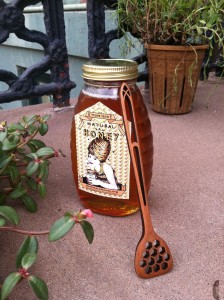 This may sound preposterous, but in many ways, the perfect urban crop is honey—or so says Meme Thomas, founder of Baltimore Honey and the organization’s Queen Bee. We’ve all heard about colony collapse disorder. But if all bees were treated like Meme’s honeybees, I’m guessing that colony collapse would not be the problem that it is today. What’s so special about her approach? For starters, she keeps her bees in downtown Baltimore.
This may sound preposterous, but in many ways, the perfect urban crop is honey—or so says Meme Thomas, founder of Baltimore Honey and the organization’s Queen Bee. We’ve all heard about colony collapse disorder. But if all bees were treated like Meme’s honeybees, I’m guessing that colony collapse would not be the problem that it is today. What’s so special about her approach? For starters, she keeps her bees in downtown Baltimore.
Suburban bees are distressed bees, she says. A perfect lawn without a weed in sight is like a food desert to a bee. The insects thrive on clover, dandelions, and wild flowers—the very things suburban gardeners strive to eradicate. And the lawn chemicals that kill off these weeds are toxic to bees too, so they suffer doubly.
Commercial bees are also a troubled lot. They’re hauled long distance from one farm to another to pollinate monocropped fields. The journey alone is stressful enough. And what do they get in return? A monotonous diet of pollen and nectar from a single crop. “Bees need a balanced diet, just as we do,” says Meme. “They should have pollen and nectar from a variety of plants.”
Even worse is the pure junk food they receive when commercial honey growers harvest the honey in the hive. Instead of leaving enough to see the bees through the winter, growers feed them sugar water or high fructose corn syrup, which provide calories but not nutrition. Sound familiar?
Now let’s turn to Meme’s Baltimore bees. Instead of monocropped fields or toxic lawns, they feed on community gardens, urban farms, and even wildflowers that grow between cracks in the sidewalk—on plants that aren’t treated with a lot of chemicals—and Meme provides weekly supplies of fresh chlorine-and-fluoride-free water, so the bees don’t need to resort to toxic runoff for liquid. Unlike commercial honey growers, too, she doesn’t smoke the bees out when it comes time to harvest the honey. “The smoke traumatizes the bees and depresses their immune systems,” she says. “And all the biomass from the smoke gets into the wax and the brood of young bees. It’s like entering a house where there’s been a fire.” Instead, she gently mists the hives, so the bees think it’s raining and retreat to the inner parts of the hive, allowing her to harvest. Finally, she leaves the bees at least 80 pounds of honey for the winter, taking only 5-10, so they don’t have to feed on sugar water.
And you can taste the results. This is the most flavorful, complex honey I’ve ever tried. It’s won blue ribbons from the Maryland State Fair.
To order a jar, you purchase a “share” in her CSA (“community-supported apiary”). The cost is $45, which seems steep (maybe even vertiginous) for a single jar. But as Meme says, “The real crop is healthy honeybees.” Given that bees pollinate a third of our food crops—including apples, blueberries, strawberries, peaches, almonds, cucumbers, melons, and scores of others—the investment in our food security seems well worth it. And you get an astonishingly good jar of honey, too!
